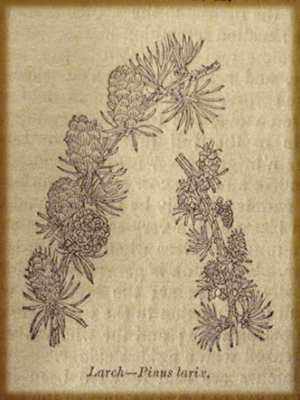
Timber: Larch
The more modern botanists divide the Pine family into three genera: Pinus, Abies and Cedrus, to the last of which the larch belongs.
The LARCH (Pinus larix) is, after the common pine, the most valuble. Though a native of more southern regions, it thrives in Britain, and it grows more rapidly and in a wider range of soils. In the south it reaches a great height. Some beams of larch used in public buildings in Venice are a hundred and twenty feet long. In Perthshire, some larches are a hundred feet high.
The larch sheds its leaves, which probably helps it survive bitterly cold winds in early spring which are destructive to pines. The trunk is generally straight, tapering to a point. The branches taper up in the form of a perfect cone. The whole is a lively brown, streaked with a golden colour.
A few larches were introduced into this country in the early sixteen hundreds, but larch was only cultivated as a forest tree after the middle seventeen hundreds.
The quality of larch timber does not depend so much on the maturity of the tree or the slowness of its growth, unlike the pine. Fishing boats of larch last a lot longer than similar boats of Norway pine. It is not so bouyant or elastic, and does not dry so completely, and boards of it are aprt to warp. It is, however, more tough and compact, and burns with more difficulty than pine. If external timbers and internal beams were made more often of larch, fires would be less frequent and less destructive. Before a beam of larch is charred on the surface, a similar beam of oak or pine will be flaming.
Larch is heavier to transport and elevate and much harder to work than pine. It is a safe and durable timber, but not the builder's favourite. Venetian houses constructed of it show no signs of decay, and the preservation of some of the finest Italian paintings owes something to the panels of larch on which they are executed.
The objects for which larch seems preferable are chiefly gates, palings, posts in the ground or in water, wooden buuildings, many agricultural implements, cottage furniture, bridges and gangways, carriages for transporting stones, barrows for builders and road makers, lighters, fenders, embanking piles, lock and dock gates, coal and lime wagons, vessels for carrying lime, pit-props, and hop-poles. For all these purposes and many others, larch would come cheaper than any timber now in use, and would last at least thrice as long.
Woodcut:

Larch: Pinus larix.
summarised from "The Library of Entertaining Knowledge - Timber trees" (1829), pub. Charles Knight, Pall Mall.
ND, habitat21
big turbines
small turbines